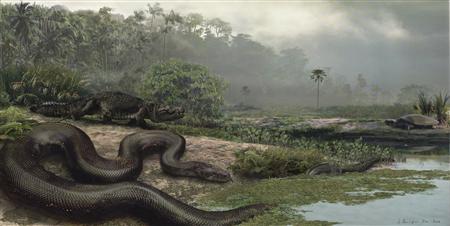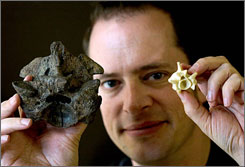
February 4, 2009
The colossal newly discovered snake Titanoboa cerrejonensis, from Colombia. Jason Bourque, University of Florida/Handout
“Indiana Jones take heart: A snake on the loose 58 million years ago would help everyone understand your phobia,” exclaimed Janice Lloyd at USA Today.
“It was the all-time titan of snakes — a monster as long as a Tyrannosaurus rex that stalked a steamy South American rain forest after the demise of the dinosaurs and ate crocodiles for breakfast, lunch and dinner,” noted Will Dunham of the News Daily.
“Any character in a B-list film would yelp ‘Snake? Snaaaake!’ upon spotting a specimen stretching longer than a school bus – and now scientists have uncovered the remains of such a beast,” wrote Jeremy Hsu at PopSci.

Jason Head of the University of Toronto holds up a giant vertebra of Titanoboa, left, and the vertebra of a 17-ft long modern green anaconda. Photo by Diane Scott, USA TODAY
“It is a mind-bogglingly big snake. This thing is a crocodile eater, catching and eating them in the water. It was a bad day for the crocs,” paleontologist Jason Head of the University of Toronto Mississauga said in a media interview.
Paleontologist Jonathan Bloch of the University of Florida’s Florida Museum of Natural History said, “When people think of Tyrannosaurus rex and how huge that thing was, this really is in the order of magnitude of Tyrannosaurus rex, in terms of length and in terms of caliber of gigantic.”
“At its greatest width, the snake would have come up to about your hips. The size is pretty amazing,” said co-author P. David Polly, from Indiana University at Bloomington. “Probably like an anaconda, it spent a lot of time in the water.”
The headlines and exciting remarks will be forthcoming for the next 48 hours, no doubt. A giant fossil snake has been discovered.
An international team of scientists on February 4th announced the discovery in northern Colombia of fossil remains of the largest snake ever known to have lived. It is named Titanoboa cerrejonensis, meaning titanic boa from Cerrejon, the open-pit coal mine where its fossils were found.
Titanoboa was at least 43 feet long, weighed 2,500 pounds (1,140 kg) and its massive body was at least 3 feet (1 meter) wide, they wrote in the journal Nature.
It was the largest inhabitant of a hot, lush tropical rain forest and probably hunted forms of crocodiles, large fish and big fresh water turtles. It was not venomous and likely lived a lifestyle akin to the large river-dwelling anacondas of today, wrapping around its unfortunate prey.
Titanoboa lived 58 million to 60 million years ago, when Earth’s animal kingdom was still recovering from the mass extinction that doomed the dinosaurs and many other creatures 65 million years ago when an asteroid hit near the Yucatan coast of Mexico. It may have been the largest non-ocean vertebrate then on Earth.
Its ecosystem was similar to today’s Amazon rain forest but hotter. The researchers estimated a snake of its size would have needed an average annual temperature in equatorial South America of 86 to 93 degrees Fahrenheit (30 to 34 degrees Celsius) to survive.
Of modern snakes, Titanoboa is most closely related to boa constrictors, except that it was the length of a school bus.
The scientists recovered fossil vertebrae and ribs, but no skull or teeth, from 28 different individuals. They think the largest Titanoboa may have been 49 feet or longer.
Previously, the largest known snake was Gigantophis (above and below), which lived about 39 million years ago in Egypt and was at least 33 feet long. The longest of today’s snakes is the reticulated python, measuring perhaps 30 feet.
Of course, for cryptozoology, this places before us a new candidate for reports already overflowing from our files! South America may be revealing its secrets, after all.
Sources (all Feb. 4th): “Titanic ancient snake was as long as Tyrannosaurus,” by Will Dunham, News Daily; “Fossilized remains of mammoth snake discovered,” by Janice Lloyd, USA Today; “Largest Snake on Earth Uncovered,” by Jeremy Hsu, PopSci. Also, see chapter on “Giant Snakes” in Mysterious America; references to giant cryptid snakes in Cryptozoology A to Z: The Encyclopedia of Loch Monsters, Sasquatch, Chupacabras, and Other Authentic Mysteries of Nature.
Thanks to Bob Matawan, Anthony T. Hartman and Richard Hendricks, for their alerts to this news.
About Loren Coleman
Loren Coleman is one of the world’s leading cryptozoologists, some say “the” leading living cryptozoologist. Certainly, he is acknowledged as the current living American researcher and writer who has most popularized cryptozoology in the late 20th and early 21st centuries.
Starting his fieldwork and investigations in 1960, after traveling and trekking extensively in pursuit of cryptozoological mysteries, Coleman began writing to share his experiences in 1969. An honorary member of Ivan T. Sanderson’s Society for the Investigation of the Unexplained in the 1970s, Coleman has been bestowed with similar honorary memberships of the North Idaho College Cryptozoology Club in 1983, and in subsequent years, that of the British Columbia Scientific Cryptozoology Club, CryptoSafari International, and other international organizations. He was also a Life Member and Benefactor of the International Society of Cryptozoology (now-defunct).
Loren Coleman’s daily blog, as a member of the Cryptomundo Team, served as an ongoing avenue of communication for the ever-growing body of cryptozoo news from 2005 through 2013. He returned as an infrequent contributor beginning Halloween week of 2015.
Coleman is the founder in 2003, and current director of the International Cryptozoology Museum in Portland, Maine.
Filed under Breaking News, Cryptomundo Exclusive, Cryptotourism, CryptoZoo News, Extinct, Fossil Finds, Giant Cryptid Reptiles